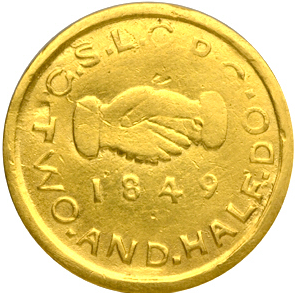by Doris White
Many people have called Joseph Smith a gold digger, but who knew that Mormon gold would one day be so valuable? The early history of Latter-day Saints (“Mormons”) in the Utah Territory certainly wouldn’t have led anyone to believe it.
When members of The Church of Jesus Christ of Latter-day Saints (which church is often inadvertently referred to as the “Mormon Church”) first entered the Salt Lake Valley in Utah in 1847, they had little or no money. They had all had to leave behind homes and many of their most prized possessions, including property. The church leader at the time himself, Brigham Young, only carried $50 with him. When you think about it, what was the use of money? There was no one there, nothing to buy.
However, as time went on, the lack of a standard currency (Utah was not an official part of the United States at the time), presented unique challenges for the Mormon population. They came up with some inventive ways to meet that challenge.
Myriad Currencies Used in Mormon History
Early on, Mormon settlers interacted with many different people. On the frontier, Spanish dollars, French francs, and other foreign coins were used right alongside U.S. coins. However, it was difficult for everyone to keep any kind of exchange rates straight.
Douglas Nyholm, a currency expert, has written a book on how Mormons have created the most diverse array of currency outside of the U.S. government. The first paper money printed in the valley was called white notes or valley notes. Other notes included those from the Salt Lake City Corporation, scrip from different cooperatives, and reissued currency from a failed bank in Kirtland, Ohio, where many of the Saints had lived previous to migrating to Utah. There was even a type of note, issued by Deseret Currency Association, which was backed by livestock—the only currency in U.S. history of which that can be said.
Due to the myriad of currencies, it was difficult for these people to do business outside of Utah, where none of these currencies were recognized. The Utah Mormons needed gold, but there was an obvious lack of it. That is, until members of the Mormon Battalion, which had marched West to serve in the war with Mexico, arrived in the Utah Valley from the end of their march in California with thousands of dollars worth of gold dust.
Mormon Gold Coins
Finally, the Mormons had a source to mint their own gold coins, which they did—the first coins to be minted from California gold. However, few of these coins survive. Many were melted down outside of Utah and made into other things. This rarity makes them exceedingly valuable today. Bob Campbell, a coin dealer, stated that there are rarely more than a dozen Mormon gold coins on the market at any given time. They can be worth from $10,000 to perhaps $1,000,000. Campbell owns one of two-dozen-existing $20 Mormon gold pieces, which is worth about $350,000. The most coveted Mormon gold piece is the $10, which can be worth up to $1,000,000.
Eventually, the Utah Territory was admitted to the Union and standard U.S. currency has been standard for quite some time. Learn more about Mormon history and early pioneer settlers by exploring the rest of our website.


 Watch a video about the restoration of the gospel on lds.org
Watch a video about the restoration of the gospel on lds.org
Thank you for this! I grew up (and currently live) in Kansas City, less than a mile from the Missouri state line, but had no real understanding of Mormon history until taking it on in earnest over the past decade.
Although the history of “Mormon Gold” coinage and currency largely bypasses events which took place in and around Independence, Missouri—at the time, Saints used U.S. and regional bank currency for the most part, being driven from the State by the Governor Boggs’ Extermination Order in 1838 before having the oppurtunity to build a Temple, let alone found a new bank—the story of Mormon currency and the coinage produced upon arrival in the Utah (Deseret) Territory has intrigued me thoroughly, with very detailed accounts accompanying in partiular online auctions in recent years by Heritage Auctions (www.HA.com), which I recommend to the interested.
The video clip you’ve included regarding currency is a wonderful “teaser” on this subject. Sadly, as you’ve pointed out, the vast majority of Mormon Gold coinage was melted down for its alleged sub-standard weight or alloyed gold value, though this appears largely to have been the result of a slur, rumors invented and directed against early Utah pioneers by their trading rivals and critics.
As late as 1933, when Roosevelt recalled US gold coinage from general circulation, Mormon Gold was still being turned in and melted in exchange for its “face value” in paper money. What a shame…
Again, thank you for the post. I’ve tweeted a link today to it, which perhaps a few will follow… But it is a big, and to me a vastly fascinating, subject… if I had the means (I was a childhood coin collector in truest sense, culling interesting coins from circulation) this would certainly be an area of focus.